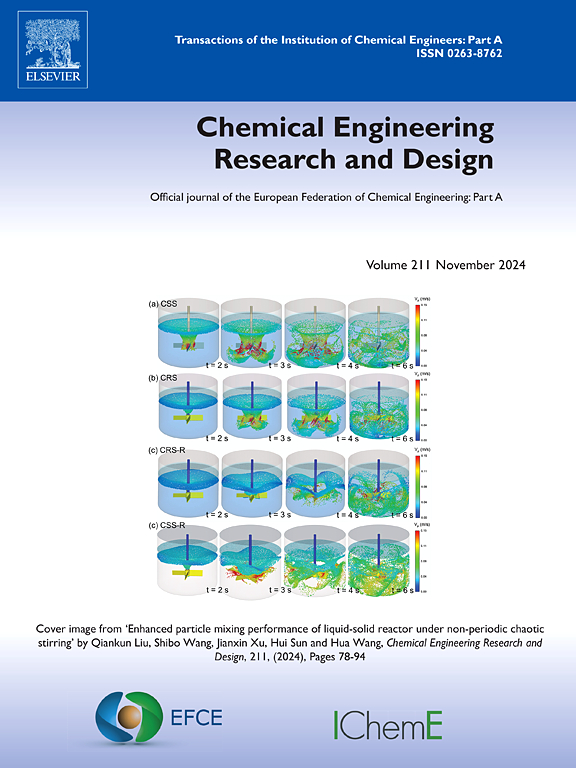用聚乙二醇接枝氧化石墨烯纳米片改性的聚砜基底可提高正向渗透性能
IF 3.7
3区 工程技术
Q2 ENGINEERING, CHEMICAL
引用次数: 0
摘要
在正向渗透(FO)过程中,调整基底层的物理化学性质和形态对于设计高性能的薄膜复合膜(TFC)具有重要意义。本文将聚乙二醇接枝氧化石墨烯(PEG-g-GO)纳米片加入到多孔聚砜(PSf)衬底的铸造溶液中,并研究了通过非溶剂诱导相分离(NIPS)工艺制备的衬底的特性。与原始的PSf基板相比,负载PEG-g- GO的基板具有更高的表面亲水性,更多孔和高连接的指状结构,更薄的致密皮层。由于这些差异,与在原始基板上聚合的选择性聚酰胺层相比,在改性基板上聚合的选择性聚酰胺层更薄、更光滑。对制备的TFC膜进行FO性能测试表明,使用改性底物制备TFC时,水通量增加,比选择性(如反盐通量,JS,对水通量,JW, ratio)和结构参数(S)降低。此外,PEG接枝到氧化石墨烯上的分子量(Mw)影响了底物的性质,从而影响了最终FO-TFC的性能。与使用裸底物的TFC相比,使用最高Mw(6000 g/mol)的PEG可使S和JS/JW分别降低40 %和23 %。这些改善比使用低Mw、1500和600 g/mol的PEG得到的改善更大。本文章由计算机程序翻译,如有差异,请以英文原文为准。
Polysulfone substrates modified with polyethylene glycol-grafted graphene oxide nanosheets for enhanced forward osmosis performance
Tuning the physico-chemical properties and morphology of the substrate layer is of great importance for designing thin film composite membranes (TFC) with high performance in the forward osmosis (FO) process. Here, polyethylene glycol grafted graphene oxide (PEG-g-GO) nanosheets were added to the casting solution of a porous polysulfone (PSf) substrate, and the characteristics of the resulting substrate prepared by the non-solvent-induced phase separation (NIPS) process were investigated. Compared to the pristine PSf substrate, the PEG-g- GO loaded substrate showed higher surface hydrophilicity, more porous and highly connected finger-like structure and thinner dense skin layer. Due to these differences, the selective polyamide layer interfacially polymerized atop the modified substrate was thinner and smoother compared to that polymerized atop the pristine substrate. The FO performance tests conducted on the prepared TFC membranes showed that the water flux increased, while the specific selectivity (as the reverse salt flux, JS, to water flux, JW, ratio) and structural parameter (S) decreased when the modified substrate was used for TFC fabrication. Furthermore, the molecular weight (Mw) of PEG grafted onto GO affected the properties of the substrate and thus the performance of the final FO-TFC. PEG with the highest Mw investigated (6000 g/mol) resulted in a 40 % and 23 % reduction in the parameter S and JS/JW, respectively, compared to TFC with the bare substrate. These improvements were greater than those obtained using PEG with lower Mw, 1500 and 600 g/mol, respectively.
求助全文
通过发布文献求助,成功后即可免费获取论文全文。
去求助
来源期刊

Chemical Engineering Research & Design
工程技术-工程:化工
CiteScore
6.10
自引率
7.70%
发文量
623
审稿时长
42 days
期刊介绍:
ChERD aims to be the principal international journal for publication of high quality, original papers in chemical engineering.
Papers showing how research results can be used in chemical engineering design, and accounts of experimental or theoretical research work bringing new perspectives to established principles, highlighting unsolved problems or indicating directions for future research, are particularly welcome. Contributions that deal with new developments in plant or processes and that can be given quantitative expression are encouraged. The journal is especially interested in papers that extend the boundaries of traditional chemical engineering.
 求助内容:
求助内容: 应助结果提醒方式:
应助结果提醒方式:


